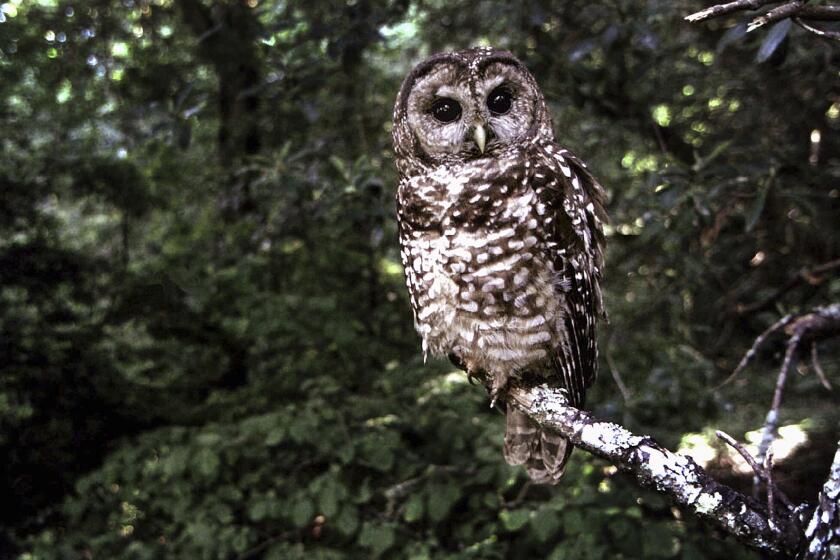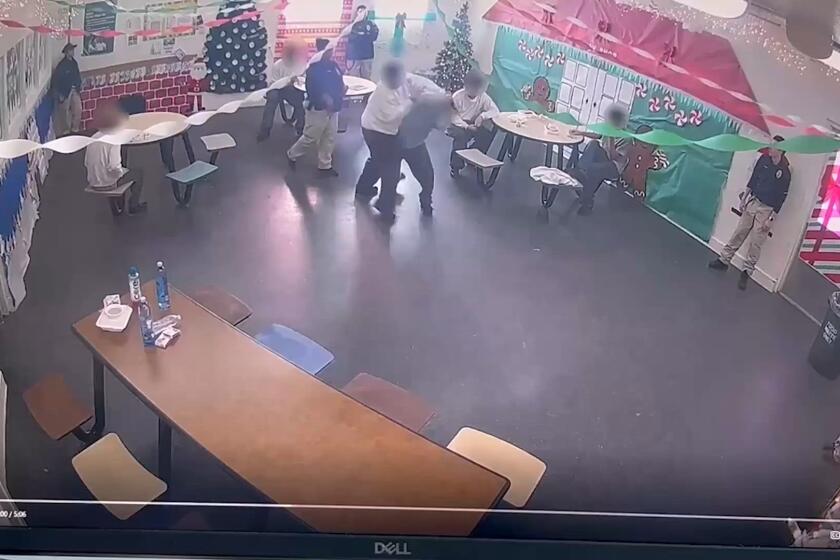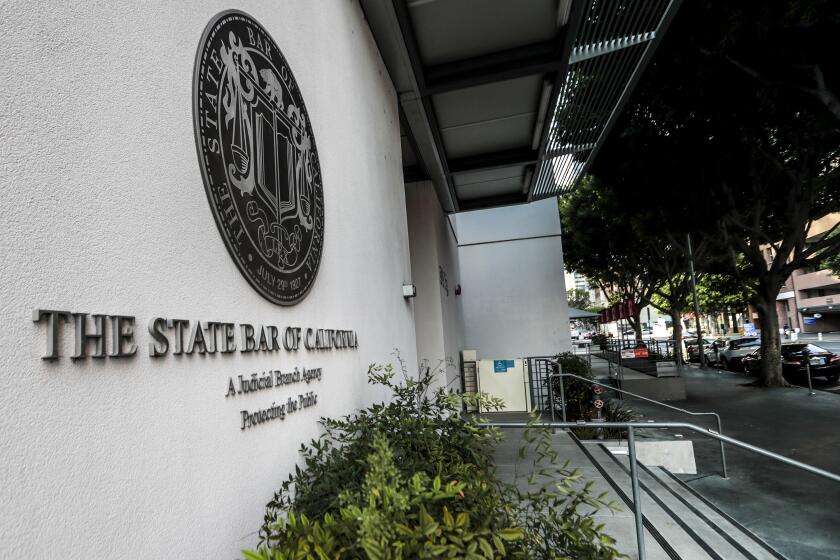City of Angels’ First Name Still Bedevils Historians
- Share via
The name of the game is historical accuracy. Everyone agrees on that.
What historians cannot agree on is the name given to Los Angeles when its Spanish founders formed it Sept. 4, 1781.
For the record:
12:00 a.m. March 30, 2005 For The Record
Los Angeles Times Wednesday March 30, 2005 Home Edition Main News Part A Page 2 National Desk 1 inches; 34 words Type of Material: Correction
Los Angeles’ name -- An article in Saturday’s A section about the original name of Los Angeles referred to Tom Andrews, the executive director of the Historical Society of Southern California, as Tom Anderson.
The early settlers meant to name the town after angels; that much is known. But for more than 75 years, local historians have been quarreling over its actual moniker.
Some contend it was El Pueblo de Nuestra Senora de los Angeles.
Others assert it was El Pueblo de Nuestra Senora la Reyna de los Angeles.
Or perhaps it was El Pueblo de Nuestra Senora de los Angeles de la Porciuncula. Or El Pueblo de Nuestra Senora la Reyna de los Angeles del Rio Porciuncula. Or maybe El Pueblo de la Reina de los Angeles Sobre el Rio de Porciuncula. Or Pueblo del Rio de Nuestra Senora la Reyna de los Angeles de Porciuncula.
How about plain old Ciudad de los Angeles?
History books, scholarly papers, encyclopedia entries and bronze plaques scattered around the downtown Olvera Street plaza to commemorate the city’s birthplace use differing versions of the name.
And now the Historical Society of Southern California has produced a book in hopes of settling the dispute once and for all.
Fat chance. Or as the founding fathers might have put it: Ni cuando!
Instead, publication of “The Founding Documents of Los Angeles, A Bilingual Edition,” has only intensified the debate among historians about the city’s true first name -- even pitting its editor against a longtime friend who thinks his thesis is wrong.
The book is a farewell project of longtime Los Angeles historian Doyce B. Nunis Jr. He retired this month after 43 years as editor of the historical society’s respected journal, the Southern California Quarterly.
“The Spanish named Los Angeles El Pueblo de la Reyna de los Angeles. That means ‘the town of the Queen of Angels,’ ” Nunis said.
Thumbing through the book to Page 158, he pointed to a reproduction of a 220-year-old map from UC Berkeley’s Bancroft Library.
“You see it at the top of the map, ‘El Pueblo de la Reyna de los Angeles.’ That’s the name on the first handwritten map in 1785. You have to look at the original documents, and that’s what we’ve done. The name is right there.” The map uses “Reyna”; other sources spell it “Reina.”
The bronze plaque at the Olvera Street plaza beneath the statue of Spanish King Carlos III, who ordered “the founding of El Pueblo de la Reina de los Angeles in 1781,” is correct, Nunis said.
But a few steps away, the founder’s plaque, which calls the city El Pueblo de la Reina de los Angeles Sobre el Rio de Porciuncula -- “the town of the Queen of Angels on the Porciuncula River” -- is wrong, according to Nunis.
So is the inscription on the plaque beneath Felipe de Neve’s statue, which describes him as “founder of El Pueblo de Nuestra Senora la Reina de Los Angeles.” Not to mention the inscription on the carved wooden cross at the top of Olvera Street, which also refers in Spanish to “the town of Our Lady the Queen of the Angels.”
Nunis blames much of the confusion on an early Franciscan priest who helped establish California’s chain of missions and in the mid-19th century wrote about his and Father Junipero Serra’s experiences.
Father Francisco Palou described how early settlers founded the future “town of Nuestra Senora de los Angeles on the banks of the river named Porciuncula.”
“The culprit was Palou. It was an honest mistake. But the pueblo was never called that,” Nunis said. “It was called El Pueblo de la Reyna de los Angeles.”
Does that mean L.A.’s Our Lady of the Angels Cathedral is also misnamed? Nunis grinned nervously.
“It’s an appropriate name for a cathedral. But if you’re naming the cathedral after the city, it’s not accurate. Frank Weber disagrees. He’s a dear friend. We agree on everything but this. We just don’t talk about this,” Nunis said.
“Frank Weber” is Msgr. Francis J. Weber, the Los Angeles Archdiocese’s historian and chief archivist. He and Nunis have been best friends for 45 years. Weber is convinced that the city’s correct original name is El Pueblo de Nuestra Senora de los Angeles de Porciuncula, or “the town of Our Lady of the Angels of Porciuncula.”
“It’s the only thing I know of that we don’t agree on,” confirmed Weber. “Of course, he’s wrong and I’m right.”
The words la Reina, or “the queen,” are an interpretation that came long after Portola Expedition diarist Juan Crespi wrote of stopping on July 31, 1769, next to the Los Angeles River, according to Weber. Crespi designated the river “in honor of Nuestra Senora de los Angeles de la Porciuncula,” a title derived from an approaching Franciscan religious celebration.
“Crespi named the city after the feast day that fell on the date they were here,” Weber said.
What about the “founding documents” reproduced in the historical society’s book?
The Queen of Angels name “was a mistake made at the time the map was drawn. You will see that name in contemporary documents by mistake. This la Reina was a mistake from the very first,” Weber said.
“Doyce and I have always disagreed on this one thing.”
They remain friends, however. They have reserved future close-together crypt space at the cathedral “so we can play pinochle Tuesday nights” forever, as Weber put it.
Weber, 72, lives and works at the San Fernando Mission. He is a historian as well as the author of more than 100 books. One book he wrote in the 1960s explored the naming of Los Angeles, he said.
“My book was the last word on it,” he said of the confusion over names, which he acknowledged exists on historic plaques at Olvera Street. “The names on the plaques depend on where they looked for information to put on the plaque. If they’d looked in my book, they would have gotten the last word.”
Nunis, 80, lives in Los Feliz in a home jammed with 4,000 books on Los Angeles and Western history. The author or editor of 61 books, he is a retired and much-honored USC history professor.
He said he proposed publishing “The Founding Documents of Los Angeles” after discovering that the few surviving copies of a 1931 historical society publication that used original Spanish documents to trace the city’s name were disintegrating because of old age.
The 1931 publication riled some historians, as did a 1973 Southern California Quarterly article that reiterated the findings. “It caused a wave of discontent. A lot of people said, ‘That’s not true!’ and I said, ‘You have to go back and look at the original documents,’ ” Nunis said.
Grants and donations from the historical society and a book lovers’ group called the Zamorano Club of Los Angeles paid to print the new book on long-lasting acid-free paper and have it distributed free to colleges and universities and public libraries, Nunis said.
Tom Anderson, historical society president, said the goal is to present “an accurate picture of the past” for future scholars.
“L.A. is fast-paced. We kind of live in the future. We tear things down quickly,” he said.
Nunis and Weber agree that names have often become muddled in Los Angeles’ relatively short history -- 223 years if you count from the 1781 date when the first settlers founded the city, (or 235 years if you measure from the 1769 date that Crespi and the Portola Expedition passed through.
“Misspelled names are the No. 1 problem. Incorrect dates are second,” Nunis said.
For example, plaques and signs outside the old church next to the Olvera Street plaza variously label and date it as “Plaza Catholic Church 1822,” “Mission Nuestra Senora Reina de los Angeles founded Sept. 4 1781” and “Our Lady Queen of Angels built in 1814.”
“They’re all wrong,” Weber said. “La Placita de Nuestra Senora de los Angeles is the name of the plaza church.” And it was founded in 1784.
“The fun of being an historian,” he said, is knowing the right name.
*
(BEGIN TEXT OF INFOBOX)
What’s in a name
Some of the many variations on Los Angeles’ name, with English translations:
Spanish: El Pueblo de Nuestra Senora de los Angeles
English translation: The Town of Our Lady of the Angels
--
Spanish: El Pueblo de Nuestra Senora la Reyna de los Angeles
English translation: The Town of Our Lady the Queen of the Angels
--
Spanish: El Pueblo de Nuestra Senora de los Angeles de la Porciuncula
English translation: The Town of Our Lady of the Angels of the Portiuncula
--
Spanish: El Pueblo de Nuestra Senora la Reyna de los Angeles del Rio Porciuncula
English translation: The Town of Our Lady theQueen of the Angels of Portiuncula River
--
Spanish: El Pueblo de la Reina de los Angeles Sobre el Rio de Porciuncula
English translation: The Town of the Queen of the Angels by the Portiuncula River
--
Spanish: Pueblo del Rio de Nuestra Senora la Reyna de los Angeles de Porciuncula
English translation: The Town of the River of Our Lady the Queen of the Angels of Portiuncula
--
Spanish: Ciudad de los Angeles
English transation: City of the Angels
--
Spanish: El Pueblo de la Reyna de los Angeles
English translation: The Town of the Queen of the Angels
--
Spanish: El Pueblo de la Reina de los Angeles
English translation: The Town of the Queen of the Angels
--
Spanish: El Pueblo de Nuestra Senora la Reina de los Angeles
English translation: The Town of Our Lady the Queen of the Angels
--
Spanish: El Pueblo de Nuestra Senora de los Angeles de Porciuncula
English translation: The Town of Our Lady of the Angels of Portiuncula
More to Read
Sign up for Essential California
The most important California stories and recommendations in your inbox every morning.
You may occasionally receive promotional content from the Los Angeles Times.











